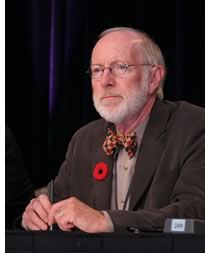

12/2005

The U.S. Green Building Council honored its 2005 Leadership Awards recipients—who include a number of architects and architecture firms—on November 10 in Atlanta at its annual conference. The Greenbuild Conference & Expo drew more than 5,000 attendees involved in the burgeoning green building movement.
The awards recognized excellence in green design and construction. Each Leadership Award category recognized one organization and one individual. The awards were presented in six categories:
- Community
- Education
- LEED
- Organizational Excellence
- Research
- Advocacy.
The Leadership Awards winners, organized by category, are:
Community
 The Kresge Foundation, recognized
for its green initiatives, including its national program that provides
nonprofit organizations with educational materials and funding for
designing green buildings. The foundation’s grants support a
range of organizations. On the Kresge Foundation Web site, President
and CEO John E. Marshall states: “It’s not just the buildings.
We look very carefully at the programs to be housed in the buildings,
and at the organizations that propose them.”
The Kresge Foundation, recognized
for its green initiatives, including its national program that provides
nonprofit organizations with educational materials and funding for
designing green buildings. The foundation’s grants support a
range of organizations. On the Kresge Foundation Web site, President
and CEO John E. Marshall states: “It’s not just the buildings.
We look very carefully at the programs to be housed in the buildings,
and at the organizations that propose them.”- Bob Berkebile, FAIA, founding principal of BNIM Architects, honored for his lifelong commitment to sustainability, both as founding chair of the AIA’s Committee on the Environment (COTE) and his service on the USGBC Board of Directors. Berkebile is credited with restoring social, economic, and environmental vitality to communities. Current AIA COTE Chair Vivian Loftness, FAIA, has praised Berkebile for advancing the green movement and pioneering COTE. Berkebile is highly regarded by fellow professionals. “This award is not an individual victory, but a cooperative achievement thanks to the steadfast support of numerous visionary volunteers within the green building industry,” says Berkebile. “I truly stand on the shoulders of giants past and present in the environmental and green design movement.”
Education
 The Croxton Collaborative, celebrated
for its instrumental work in defining criteria used to establish goals
and practices in green architecture. The Croxton Collaborative was
founded by Randolph R. Croxton, FAIA. In an interview with the Natural
Resources Defense Council, Croxton stated, “I like to say that
what we do at Croxton is more than just build structures; we create
environments for people. The way I see it, a building is more than
an object—it is inherently part of a complex of built and natural
systems. It’s my job to optimize or reconcile the relationship
between those two systems.”
The Croxton Collaborative, celebrated
for its instrumental work in defining criteria used to establish goals
and practices in green architecture. The Croxton Collaborative was
founded by Randolph R. Croxton, FAIA. In an interview with the Natural
Resources Defense Council, Croxton stated, “I like to say that
what we do at Croxton is more than just build structures; we create
environments for people. The way I see it, a building is more than
an object—it is inherently part of a complex of built and natural
systems. It’s my job to optimize or reconcile the relationship
between those two systems.”- Traci Rider of Alliance Architecture was praised for integrating students and young professionals into the green building movement. She is the chair and founding member of USGBC’s Emerging Green Builders. Rider also created and led the USGBC Design Competition for students and young professionals in exceptional project design using LEED. “Students and young professionals need resources,” says Rider. “We are growing really quickly; there are a good number of emerging green builders out there. Enthusiasm and energy characterize the emerging green builder. We hope to bring in industrial designers and artists to broaden our scope of green building. The more we broaden our scope, the more we understand how our specific profession interacts with others in the movement.”
LEED
 The
New York State Energy Research and Development Authority (NYSERDA) was
acknowledged for pioneering a green building program in the state
of New York based on the principles of LEED. Senior NYSERDA project
manager Craig Kneeland led the force for green building in New York
with the New York State Green Building tax credit legislation. “NYSERDA
is proud to receive the 2005 USGBC Leadership Award in the LEED category,” says
Kneeland. “We realize that it is one of the most prestigious
awards in the green building industry. NYSERDA is pleased to join
Governor Pataki, a 2001 recipient of this award, and Tim Carey, former
president and CEO of the Hugh L. Carey Battery Park City Authority
(BPCA), who received the Advocacy Award this year (see below). It
is our hope that this award enables other governmental agencies to
establish Green Building Programs in states and localities throughout
the country.”
The
New York State Energy Research and Development Authority (NYSERDA) was
acknowledged for pioneering a green building program in the state
of New York based on the principles of LEED. Senior NYSERDA project
manager Craig Kneeland led the force for green building in New York
with the New York State Green Building tax credit legislation. “NYSERDA
is proud to receive the 2005 USGBC Leadership Award in the LEED category,” says
Kneeland. “We realize that it is one of the most prestigious
awards in the green building industry. NYSERDA is pleased to join
Governor Pataki, a 2001 recipient of this award, and Tim Carey, former
president and CEO of the Hugh L. Carey Battery Park City Authority
(BPCA), who received the Advocacy Award this year (see below). It
is our hope that this award enables other governmental agencies to
establish Green Building Programs in states and localities throughout
the country.”- Paul von Paumgartten, Johnson Controls, was honored for his years of service in the development of the LEED for New Construction and for the Existing Buildings rating systems. Both as a member and as chair of LEED committees, and for his leadership within Johnson Controls, von Paumgartten has brought the message of sustainability, especially its triple-bottom-line value, to many organizations. Additionally, von Paumgartten formed an internal “Green Team” that includes more than 50 people from Johnson Controls who have become LEED-accredited professionals. In a recent article posted on the Johnson Controls Web site, he wrote: “What many companies recognize is that sustainability is not a fad; it’s here to stay. Facility managers’ most powerful tool is LEED. It provides a roadmap for smart facility managers to help their organizations save money, help the environment, and keep people healthy.”
Organizational Excellence
 Gensler Architecture, Design & Planning
Worldwide, rewarded for its advancement of sustainable design.
Gensler’s innovations, under the direction of founder Art Gensler,
FAIA, focus on a green approach to corporate culture with a commitment
to a healthier workplace. Over the years, the Gensler firm has been
a key participant in the USGBC’s pilot programs that helped
to develop guidelines for LEED certification.
Gensler Architecture, Design & Planning
Worldwide, rewarded for its advancement of sustainable design.
Gensler’s innovations, under the direction of founder Art Gensler,
FAIA, focus on a green approach to corporate culture with a commitment
to a healthier workplace. Over the years, the Gensler firm has been
a key participant in the USGBC’s pilot programs that helped
to develop guidelines for LEED certification.- Ross Spiegel, AIA, Fletcher-Thompson Inc., honored for building a base of technical knowledge on which green products are manufactured. Spiegel served on the USGBC Greenbuild Steering Committee for the past four Greenbuild conferences. In a Green Forum interview, Spiegel stated: “What I always [say] to design professionals is that one of their roles during the process of bidding and constructing a project is to act as an educator, to share the information and experience they’ve obtained with the construction end, and to work directly with product manufacturers to encourage them to get out there and spend more time with contractors and educate them as well.”
Research
 The Advanced Energy Design
Guide for Small Office Buildings (AEDG-SO) was recognized for its contribution
to advance green buildings. The guide is the first in a series of
documents designed to provide recommendations for achieving 30 percent
energy savings over the minimum code requirements of ANSI/ASHRAE/IESNA
Standard 90.1-1999. AEDG-SO is a joint effort of the AIA; American
Society of Heating, Refrigerating and Air-Conditioning Engineers;
Illuminating Engineering Society of North America; and the New Buildings
Institute. “The guide is unique in that it provides specific,
prescriptive means of achieving a 30 percent savings goal with off-the-shelf
technology,” describes Kateri Callahan, president of the Alliance
to Save Energy. “It’s an enormous technical challenge
that was met with innovation and creativity. The collaboration among
ASHRAE, AIA, IESNA, and NBI to create this design guide demonstrates
strong industry leadership among professional societies.”
The Advanced Energy Design
Guide for Small Office Buildings (AEDG-SO) was recognized for its contribution
to advance green buildings. The guide is the first in a series of
documents designed to provide recommendations for achieving 30 percent
energy savings over the minimum code requirements of ANSI/ASHRAE/IESNA
Standard 90.1-1999. AEDG-SO is a joint effort of the AIA; American
Society of Heating, Refrigerating and Air-Conditioning Engineers;
Illuminating Engineering Society of North America; and the New Buildings
Institute. “The guide is unique in that it provides specific,
prescriptive means of achieving a 30 percent savings goal with off-the-shelf
technology,” describes Kateri Callahan, president of the Alliance
to Save Energy. “It’s an enormous technical challenge
that was met with innovation and creativity. The collaboration among
ASHRAE, AIA, IESNA, and NBI to create this design guide demonstrates
strong industry leadership among professional societies.”- G. Z. Brown, AIA, professor of architecture and director of the University of Oregon Energy Studies in Buildings Laboratory, was awarded for being a lifelong proponent of sustainable building practices. He was principally responsible for integrating sustainable curriculum into the University of Oregon School of Architecture. In 1985, Brown founded the Energy Studies in Buildings Laboratory and has served as its director since.
Advocacy
 Global Green was honored for
its policy initiatives since 1993 that support green buildings. Global
Green was founded as the U.S. affiliate of Green Cross International,
President Mikhail Gorbachev’s international environmental movement
to focus on global climate change, weapons of mass destruction, and
access to clean water. Global Green USA has made the greening of affordable
housing a priority and has developed and advocated policy initiatives
such as the inclusion of green criteria in the California Tax Credit
Allocation Committee Guidelines and the Los Angeles Housing Trust Fund.
The organization is headed by Matt Petersen, who pioneered the idea,
and says Global Green is inspired by Gorbachev. “He often says,
you can’t deal with the environment unless you deal with poverty.
He talks about the need for a value shift to reconnect humanity with
the environment. Dealing with human needs is critical for doing this.”
Global Green was honored for
its policy initiatives since 1993 that support green buildings. Global
Green was founded as the U.S. affiliate of Green Cross International,
President Mikhail Gorbachev’s international environmental movement
to focus on global climate change, weapons of mass destruction, and
access to clean water. Global Green USA has made the greening of affordable
housing a priority and has developed and advocated policy initiatives
such as the inclusion of green criteria in the California Tax Credit
Allocation Committee Guidelines and the Los Angeles Housing Trust Fund.
The organization is headed by Matt Petersen, who pioneered the idea,
and says Global Green is inspired by Gorbachev. “He often says,
you can’t deal with the environment unless you deal with poverty.
He talks about the need for a value shift to reconnect humanity with
the environment. Dealing with human needs is critical for doing this.”- Tim Carey, former president and CEO of the Hugh L. Carey Battery Park City Authority (BPCA) and current chief operating officer of the New York Power Authority, was praised for his leadership at BPCA. Thanks in part to his leadership, New York City Mayor Mike Bloomberg signed the city’s High Performance Buildings Bill, requiring achievement of the LEED Silver rating for all city buildings and resulting in the Big Apple becoming one of the first major U.S. cities to enact legislation requiring green building practices.
![]()
For more information,
visit the USGBC’s Web site. ![]()
![]()